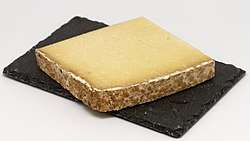Cantal cheese
Cantal cheese is a type of firm cheese produced in the Auvergne region of central France: more particularly in the département of Cantal (named after the Cantal mountains) as well as in certain adjoining districts. Cantal cheese was granted Appellation d'Origine Contrôlée certification in 1956.[1] One of the oldest cheeses in France,[2] Cantal dates back to the times of the Gauls. It came to prominence when Marshal Henri de La Ferté-Senneterre served it at the table of Louis XIV of France. Senneterre is also responsible for the introduction of Saint-Nectaire and Salers.
| Cantal | |
|---|---|
 | |
| Country of origin | France |
| Region, town | Cantal |
| Source of milk | Cows |
| Pasteurized | Depends on variety |
| Texture | Semi-hard to hard |
| Aging time | 1 - >6 months |
| Certification | Cantal, Auvergne AOC, 1956
Cantal Entre-deux, Auvergne, AOC, 1986 Cantal Jeune, Auvergne, AOC 1980 |
| Named after | Cantal mountains |
Composition
There are two types of Cantal cheese. Cantal Fermier is a farmhouse cheese made of raw milk. Cantal Laitier is the commercial, mass-produced version from pasteurized milk; both have to adhere to the same strict quality controls. Cantal is shaped like a cylinder. Cantal is made from raw or pasteurized cow's milk of the Salers breed. For Cantal, the milk of cows that are fed on hay (during 15 November to 15 April) is used; the summer milk of the same cows grazing on mountain meadows makes the Salers cheese.
This semi-hard cheese is aged for several months. The form is massive, and the cheese has a soft interior. Its flavor, which is somewhat reminiscent of Cheddar, is a strong, tangy butter taste and grows with age. A well ripened Cantal has a vigorous taste, while a young cheese has the sweetness of raw milk. The pitted appearance of the crust of Cantal vieux is a result of the activity of cheese mites. Its smell is of earth and pasture lands, and is reminiscent of the rich pasture land of the Auvergne region from which it originates. According to the time of aging, three varieties are distinguished:
- Cantal jeune (aged 1–2 months)
- Cantal entre-deux or Cantal doré (aged 2–6 months)
- Cantal vieux (aged more than 6 months).
These are all available as fermier and laitier. Most (>80% of production) Cantal is of the first two varieties. Cantal vieux is already a hard cheese, if kept properly, it can last up to a year and a half without spoiling. It is not produced in large quantities. Much loved in the Cantal region, Cantal vieux is quite rarely exported due to its strong taste and can usually be found only in specialist stores.
Cantal cheese has a fat content of 45%. It is used in soups, salads, aligot potatoes[3] cheese fondue and gratins. Cantal Fermier, like all cheeses made from raw milk, may contain Listeria bacteria on the crust, which should therefore be discarded; it is also not suitable for children, the elderly, or immunocompromised persons.
See also
References
| Wikimedia Commons has media related to Cantal (cheese). |
- "Pour l'Europe, AOP et AOC ne font plus qu'une". fromage-cantal.com/. Retrieved 7 January 2012.
- Ehlers, S.; Hurt, J. (2008). The Complete Idiot's Guide to Cheeses of the World. Complete Idiot's Guide to. Alpha Books. p. 55. ISBN 978-1-59257-714-9. Retrieved 2016-05-19.
- http://stlouiseats.typepad.com/st_louis_eats_and_drinks_/2007/10/scape.html